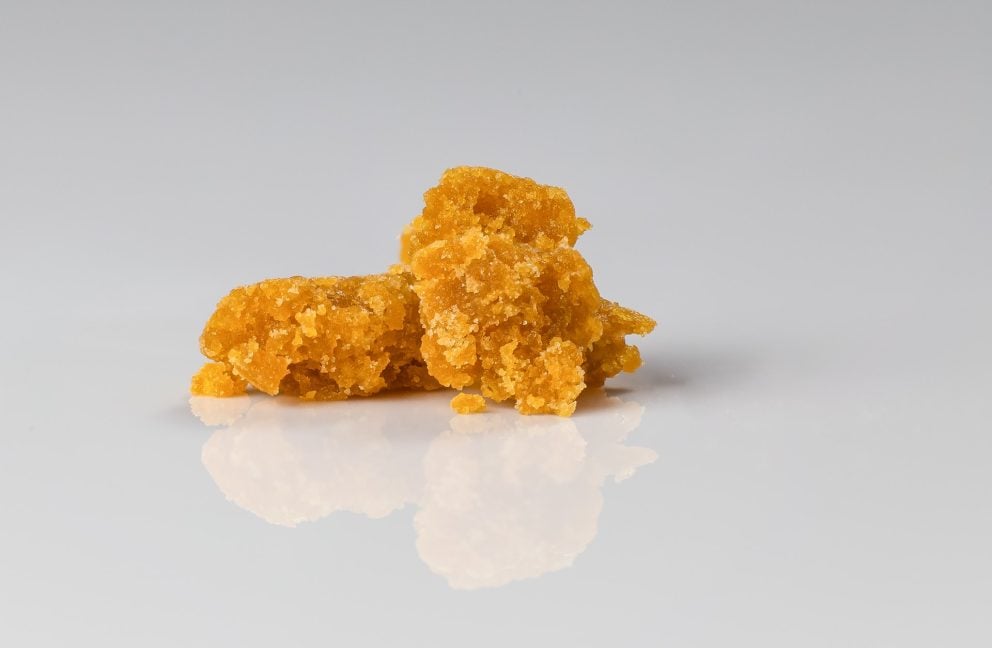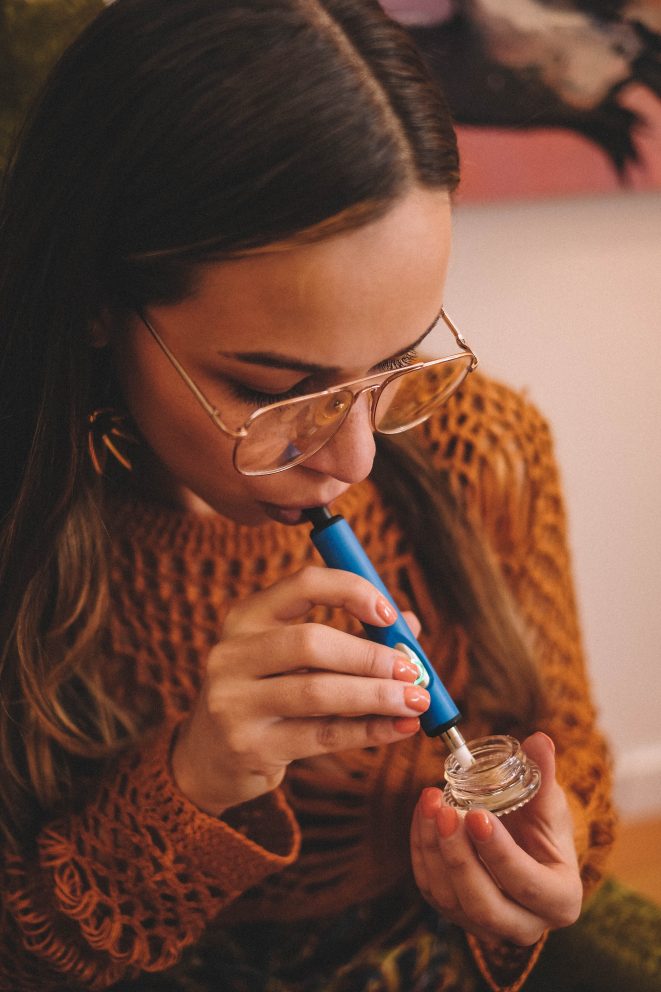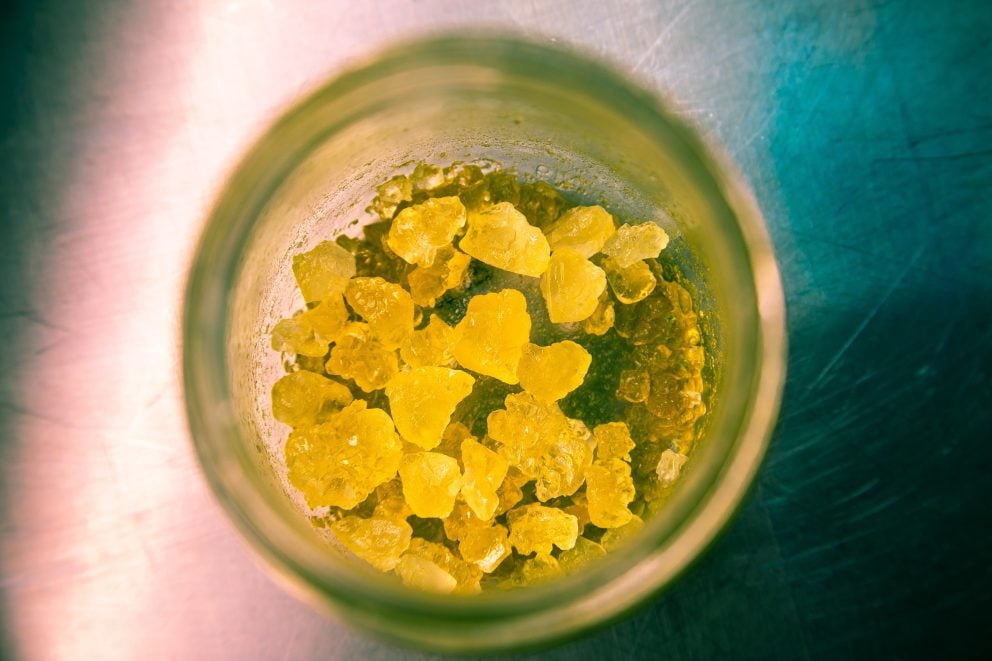
What is a Weed Dab? And What are the Different Types of Wax Dabs?

Cannabis has been used for centuries and over time, there have been new developments in weed “technology” to not just get people higher but give them access to more cannabinoids. One of these new developments is dabbing weed, which is smoking a concentrated form of cannabis called a weed dab.
While what’s driven changes in cannabis use is the pursuit of more THC and stronger highs, many of these strategies, including using concentrates and weed wax can ensure medical marijuana patients get access to more of the cannabinoids that help ease symptoms and can even serve as treatment for some conditions. Plus, it offers an alternative to standard smoking.
Apply for a Medical Marijuana Card Online Today
Join over 100,000 patients who have chosen Green Health Docs as their medical cannabis doctors. We have a 99% approval rate and offer a 100% money back guarantee!
What is a Dab?
A dab refers to a concentrated form of cannabis that’s cultivated from butane hash oil. Dabs can vary in texture and exist in a variety of types including shatter, wax, budder, or crumble.
Butane hash oil uses butane to cultivate many of the cannabinoids and some of the terpenes of cannabis which give cannabis its medicinal properties. The extraction process essentially purges most, if not all, of the plant matter. The cannabis flowers are exposed to butane and then heated in a machine that also removes the butane and the dissolved plant matter.
This process leaves behind a waxy or resinous substance, a weed wax, that is used in dabbing weed. Unlike flower that can top out at 50% THC, many dabs can be over 50% and even exceed 90% THC. On some level, dabbing is like freebasing THC in that you use chemicals to get access to pure cannabinoids and smoke that mixture.
The butane hash oil and wax aren’t heated to the temperature that creates THC so the product is full of THC-A and still requires heat so you’ll heat a dab and inhale the vapor that’s full of cannabinoids.
By eliminating a lot of the plant matter that creates carcinogens and harmful chemicals when burned, dabbing provides a more concentrated experience that is more like vaporizing as you inhale a vapor that’s mostly cannabinoids.
That being said, dabs are the result of chemical processes which means the potential for chemical remnants from the solvents used to make them. It’s important to be cautious and use dabs manufactured in states with legalized cannabis to ensure they’ve been properly lab tested and are regulated by the proper channels.
What is Dabbing Weed?
Before dabbing became a dance move and pop culture reference, dabbing referred exclusively to smoking marijuana wax or concentrates that offered more THC, cannabinoids, and a higher high. While the dance found popularity in the 2010s, weed dabs have been used as far back as the 1960s.
Soldiers in Vietnam would cover cannabis with petrol or acetone and then roll the resinous remnants into a joint. Dabbing grew in popularity as medical marijuana became legal as more cannabis users began smoking concentrations of cannabis resin, oil, or wax.
How to Smoke Dabs
Smoking dabs or dabbing weed requires you to use a specific device known as an oil or dab rig. A rig is a water pipe similar to a bong you use to smoke weed, only instead of having a bowl to load flower, it has a spot for a “nail.” The nail is where you apply your dab of concentrate.
A nail can resemble a standard nail, it has a flat end for you to place your dab and a pointy end that fits directly into the downstem of your rig the way the bowl fits into a bong. There are also optional caps you can add to avoid losing any of the smoke/vapor. The cap is placed over the nail after you’ve heated and applied your dab to retain the vapor that’s created.
People often use butane torches, think the type you use for crème brulee, to heat the nail. There are also special tools called dabbers you can use to apply your dab to the nail. The heated nail will cause your wax to melt and as it does, it releases a vapor that’s full of cannabinoids.
Some dab rigs have e-nails which can electronically heat your dab to the desired temperature and help avoid any potential for burning your dabs or yourself.
Here are the simple steps to smoke dabs:
- Aim your torch’s flame directly at the nail. Heat the nail until it turns red hot. If you’re using an electronic nail, make sure it’s thoroughly heated.
- Once the nail is hot, turn off the torch. Let the nail cool for a few seconds so the surface temperature isn’t too hot to burn your dab.
- Apply the dab directly onto the nail with your dabber and put your mouth on the mouthpiece and begin inhaling slowly. Tip: When applying the dab, try moving the dabber tip on the nail or smear it a bit to avoid wasting anything stuck to the dabber.
- Cover the dab and nail with a cap and finish inhaling. A cap will help regulate the airflow and avoid losing cannabinoids.
When smoking dabs, be careful to avoid burns when using your torch. Also, be prepared as dabs can offer a more intense and direct high. After all, dabs are concentrated so unlike regular marijuana smoke which includes cannabinoids, terpenes, smoke, and carbon dioxide, there’s a more direct amount of THC entering your lungs and bloodstream.
If using a dab rig is too complex, there are portable devices where you simply apply the device to the dab and inhale.

Photo by NisonCo PR and SEO on Unsplash
Dab vs Wax
Cannabis terminology can be vague at times and the differences between certain concepts can get lost in translation. For example, hash can be short for hashish, which is a pressed form of kief and flower, but hash is also a term that covers all forms of wax and concentrates. So hash oil, dabs, and wax can potentially be the same thing depending on the context.
Dab and wax are synonymous because dab is the process and wax is what you use. The only difference between dabs and wax is when it comes to vape pens. There are different vaporizers on the market and many vape pens are interchangeable and cartridges can fit different vape pens but those vapes all use concentrated cannabis oil.
Wax and dab vape pens are different and different from each other. Unlike standard vape pens that use oil, wax vapes require a higher heat to melt the wax. They’ll also often be covered in steel to protect your hand from the high temperature.
Dab vape pens have an inner coil that melts the dab onto a wick allowing you to inhale. They also can use different cartridges. Also, to make it even more confusing and incestuous, dab vapes are a type of wax vape but not all wax pens will necessarily work the same as a dab vape pen.
When purchasing a vape pen or vaporizer it’s best to do research to see if you’re buying what works best for you and if it “plays well” with other cartridges and products on the market.
What is Marijuana Wax?
If you hear the term marijuana wax, it’s likely referring to the same class of concentrates as dabs. Unlike the terms hash or dabs, marijuana wax is a lot more intuitive and clear. Just know that marijuana wax is another name for the same concentrates as dabs.
Different Types of Wax Dabs
Wax
Again, like with hash and dabs, wax is often the catch-all term for the various types of dabs that are sticky, soft, or waxlike. They can vary in grade, consistency, and THC content. The consistency often defines the name so waxes include budder, sugar wax, crumble, and honeycomb which are all named for their general consistency.
Wax can potentially be confused with rosin which can potentially have a similar consistency. Rosin is processed using heat and pressure and completely solventless. Despite all the similar terminology, rosin is not considered a wax but is considered a dab because all waxes are processed via a butane extraction or a CO2 extraction method.
Budder
Budder is considered one of the cleanest concentrates. It’s on average higher than 90% THC. It’s whipped repeatedly so it takes on a similar texture as butter. It tends to be on the higher end given its elaborate production process and high THC content.
Sugar Wax
Sugar wax is named for its resemblance to sugar that hasn’t quite dissolved. It was first created by accident when extracts were left out and allowed to condense and crystalize. It’s made with dried buds or fresh but frozen cannabis, which results in live resin. Sugar wax has grown in popularity due to its high terpene content and flavor profile.
Crumble
Crumble is a loose, dry extract that gets its name from its habit of breaking apart when handled. Given the challenge of handling, crumble can tend to be a bit more affordable. The bright side is its extra-low moisture level gives it a longer shelf life as it is less likely to develop mold.
Honeycomb
Honeycomb is similar to crumble and named for its porous, cavity-filled appearance when heated and its honey color.
Shatter
Shatter is one of the most famous types of dabs and is named for its hard glasslike appearance. Shatter can vary in its color and sometimes even appear clear. The color has no effect on its potency.
Crystalline
Crystalline is the most potent variety of dabs. It is pure cannabinoid crystals with a full spectrum of cannabinoids. It can often appear like a single chunk of crystal that can be broken into smaller pieces to dab. If crystalline is made up of a single cannabinoid like THC or CBD it’s often called Diamond.

Can You Dab Hash?
Again, cannabis terminology can sometimes be a bit open-ended, so there are some types of hash that you can dab and some you may not want to. You can dab all forms of hash but if you dab traditional hashish, you’ll want to be sure to clean your nail.
Hashish has plant matter and when burned, that flavor can linger if your rig is not cleaned. Other forms of hash are super dab friendly.
Is Smoking Dabs Dangerous?
It’s easy to make the argument that by smoking less of the plant matter you’re exposing yourself to less carcinogens. However, dabs do still have the potential for chemical exposure, after all, they’re made using toxic chemicals. Dabs can potentially expose you to inhaling other carcinogens.
Additionally, dabs are super concentrated which means they can have different effects than standard cannabis. A joint may have 40% THC, tops, but some dabs can be over 90% THC. This increased exposure to THC can mean you build a greater tolerance over time. They can also lead to not just paranoia but prolonged anxiety.
Dabs can also cause hallucinations and even hash-induced psychosis. A study also revealed that dabs can result in more physical dependency, engaging in risky behaviors, and personal problems.
Is Smoking Dabs Illegal?
Smoking dabs is legal in areas where cannabis is legal. However, possession of butane hash oil can be illegal in some states and the manufacture of butane hash oil is illegal even in states where cannabis is legal like California.
Butane extraction is an involved process and requires proper safety measures and machinery so trying to make it at home is not only dangerous, it’s illegal.
Do CBD Dabs Get You High?
CBD by nature does not make you high so even a dab that’s 99.9% CBD will not have any psychoactive effects. That being said, the potential benefits of CBD dabs include:
- appetite control
- stress relief
- anti-anxiety
- antioxidant
- anti-arthritic
- anti-inflammatory effects including the relief of inflammatory pain
Apply for a Medical Marijuana Card Online Today
Join over 100,000 patients who have chosen Green Health Docs as their medical cannabis doctors. We have a 99% approval rate and offer a 100% money back guarantee!
How to Make Dabs
You cannot make standard dabs (wax) at home as the process requires industry-grade chemical solvents and machines, not to mention, trying to would be dangerous and illegal. It is illegal to manufacture dabs as the process is a bit too similar to meth labs – think toxic chemicals and the potential for explosions.
That being said, there are solvent-free concentrates you make to make your own weed dabs at home. These dabs would be considered a rosin instead of a weed wax.
To make your own concentrate you’ll need a flat iron, hair straightener, or iron, bakery or parchment paper, a razor blade, an oven mitt, and 2 grams of cannabis.
- Heat the flat iron to a temperature between 250 and 300 degrees Fahrenheit.
- Split the 2 grams into four small batches.
- Fold your parchment paper in half and place your bud in the middle.
- Use the oven mitt to hold the flatiron closed and press on the nugget for 3 seconds. Or use a standard iron and hold it down for 4 seconds. Try to avoid any setting that will get it wet. (Heat it slow to not risk decarbing your cannabis)
- Repeat this same process with all four batches.
- Scratch off the resin that has formed on the paper with a razor blade.
- Use the resin scrapings to dab. You can also use the leftover bud to make edibles or cannaoil.
Can You Eat Dabs?
People seeking higher highs or more potent edibles may want to know if you can eat dabs and the short answer is yes. The only issue is it will not get you high. The different types of wax dabs are all made to be smoked.
Dabs need to be decarbed, or decarboxylated, for the THC and other cannabinoids to be available in the way you want them to. THC-A will not get you high but once it’s heated and converted to THC, especially in a dab, it can get you very high.
Weed dabs and dab wax can be used to make edibles. You’ll want to be mindful when consuming the final product to make sure you don’t have too strong a reaction as eating marijuana affects the body differently.
You also could potentially eat the remnants of used dabs from your rig, known as reclaim, and that will get you high. While there’s no guarantee on the taste you can potentially mix it with food and consume it that way you might eat an edible.
If you decide to make edibles with reclaim, be aware that it’s already been decarboxylated and overcooking could reduce the potency of THC.
Final Thoughts
Dabs offers an intense hit of cannabis with a large concentration of THC and other cannabinoids. This not only means a stronger high but also a larger concentration of the cannabinoids that are vital for medical marijuana treatment.
Dabs can offer a simpler delivery system for a higher concentration of cannabinoids. This can help with patients who have limited mobility. However, dabs can have their own pitfalls and issues so it’s important to be cautious when purchasing and using them.
If you’re curious about dabs and exploring the vast medical benefits of cannabinoids, consider applying for your medical marijuana card today to ensure you stick to the letter of the law.
This article has been reviewed by Dr. Anand Dugar, an anesthesiologist, pain medicine physician and the founder of Green Health Docs. Graduating from medical school in 2004 and residency in 2008, Dr. Dugar has been a licensed physician for almost 20 years and has been leading the push for medical cannabis nationwide.
